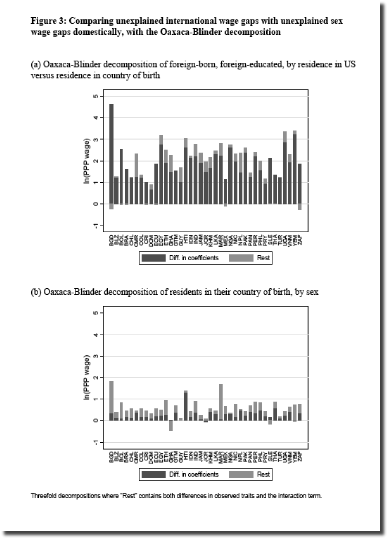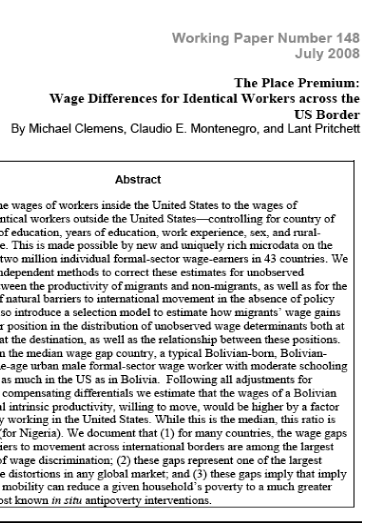The Place Premium: Wage Differences for Identical Workers across the US Border
Researchers Michael Clemens, Claudio Montenegro and Lant Pritchett applied their analytical model on microdata on the wages of over two million individual formal-sector wage-earners in 43 countries. This exercise made these researchers arrive to basically the same conclusion that constitutes the fundamental argument of Jus Semper's sole initiative: The Living Wages North and South Initiative (TLWNSI): Northern wages are much higher than Southern wages for workers of equal intrinsic productivity because of North-South exploitation and not due to price differences.
This paper compares the wages of workers inside the United States to the wages of observably identical workers outside the United States—controlling for country of birth, country of education, years of education, work experience, sex, and rural-urban residence. The authors drew fundamental conclusions:
- for many countries, the wage gaps caused by barriers to movement across international borders are among the largest known forms of wage discrimination. They arise only from socially constructed characteristics of the worker (like country of birth) that are not related to worker productivity (labor demand) or to the preferences of potential migrants (labor supply).
- these gaps represent one of the largest remaining price distortions in any global market. The differentials the researchers recorded are generally larger than price gaps for goods or financial instruments between developing countries and the US. As Jus Semper has always argued through TLWNSI, there is no relationship between the difference in wages for equivalent workers and the differences in prices between Southern countries and the U.S. based on purchasing power parities. This is all the more evident when comparing equivalent workers working for the same company in a Southern country vis-à-vis the U.S. As our living wage-gaps analysis consistently exposes every year, Southern workers earn only a fraction of what they should earn for performing the exact same job based on true price differences. Not surprisingly, the researchers, also found that the gains from a marginal relaxation on barrier to labour mobility produced welfare gains would greatly exceed the total gains to developing countries from elimination of all remaining global trade barriers.
- these gaps imply that simply allowing labor mobility can reduce a given household’s poverty to a much greater degree than most known in situ antipoverty interventions. Their estimates strongly suggest that no existing policy carried out in situ can benefit the marginal poor household as much as one year of access to the US labor market.
They also performed comparisons parting from results of concrete consumer-oriented actions such as consumer boycotts that brought the same conclusion. For instance, they looked at Harrison and Scorse (2004) finding that international anti-sweatshop campaigns against textile, footwear, and apparel plants in Indonesia caused a 20-25% increase in real wages for workers at foreign-owned and export-focused plants between 1990 and 1996. Their analysis model showed that this campaign translates to an annual wage gain of US$647 at purchasing power parity, which at a 10% discount rate has a present value of about US $6.960, which would account for 58% of the annual wage gain from working in the US. From another angle, this means that the cumulative lifetime effect of the anti-sweatshop movement on an Indonesian worker’s earnings could be earned if that person had the chance to work in the US once for a period of about 30 weeks. In summary, this rich-data analysis exposes once again the argument rhetorically used by the International Labour Organisation to position its so-called decent work agenda: that the decent work concept has led to an international consensus that productive employment and decent work are key elements to achieving poverty reduction. In other words, there is no other measure more effective to combat poverty in Southern countries than paying living wages in the South and not the misery wages that workers receive as a result of the system of customary exploitation that has been in place for centuries.
Download the full paper on wage differences for identical workers across North-South! click here or on the picture to download the pdf file.
|







